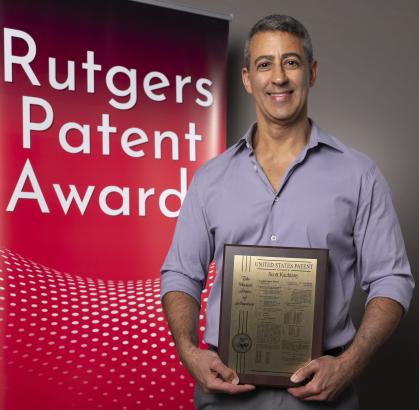Patented Scientist-Inventor
We've all run into situations where we wished something worked differently. When that happens to Associate Professor of Oral Biology Scott Kachlany, he often goes the extra mile to figure out a solution.

This mindset led him to about 12 issued and four pending patents, possibly many more to come. Frustrated with weeds in his garden, he invented a new gardening tool. Feeling stress on his wrists during pull-ups, he created a handle grip that rotates on the pull-up bar. For helping others, he devoted his career to patenting and developing a novel treatment for white blood cell diseases.
"I like to tell people I'm a scientist, and I'm mostly an inventor," he said. "In research, you're inventing ways of doing new things, whether it's an experiment, device, tool or a therapy."
Kachlany has been studying leukotoxin, a protein produced by a bacterium in the mouth. What makes this protein special is that it's not only naturally present in our bodies, but also capable of killing harmful white blood cells. After realizing these properties, Kachlany "put two and two together" and has been investigating how he could use leukotoxins as a potential therapy for white blood cell diseases like leukemia, lymphoma, psoriasis, allergic asthma, Crohn's disease, multiple sclerosis, dry-eye disease, and HIV.
"Nobody's ever studied this leukotoxin in this way," he said. "Rutgers has the only group in the world with all the patents."
About two decades ago, he conducted his first animal study, where he tested how mice with human-type leukemia and lymphoma responded to injection of leukotoxin. "Amazingly, the tumors went away and disappeared within days, with only a few doses," he said. "We have not seen any toxic effects or any adverse reactions." He took that as a sign to keep going with the work. He conducted other animal studies and began looking at different diseases. Along the way, he began to patent these indications, starting with leukemia and lymphoma and then expanding into autoimmune diseases, including psoriasis, allergic asthma, and dry-eye disease.
"This is a natural protein that is able to figure out how to kill a subset of white blood cells, and that leads to safety, which is a big thing because every drug out there has really bad toxicities," he said, like chemotherapy. "Nature has basically developed this potential therapy for us." He added that it does not harm other liver, heart, or muscle cells.
He recently licensed the technology to an animal health company that will study leukotoxin and dry-eye disease in companion animals like dogs and cats. "They get a lot of diseases that are very similar to humans like lymphoma, dry eye, certain autoimmune diseases like atopic dermatitis, eczema, or psoriasis," he said.
A few years ago, he obtained an investigational new drug approval from the Food and Drug Administration to conduct a phase one clinical study in patients with leukemia and lymphoma. He has been getting funding and hopes to start the first phase of the human trial to assess the efficiency of the drug next year.
"Once we see how it works in humans, we can then move laterally into the other diseases," he said, "and that's the exciting part that it has such broad applications."



